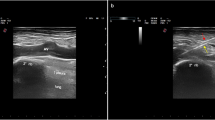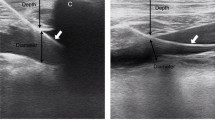Abstract
Background
Blind axillary venous access is a convenient but technically difficult approach for cardiac rhythm device lead implantation. We try to explore whether there are rules on the axillary vein course to facilitate blind venous cannulation.
Methods
In a single-center, retrospective study, we included 155 patients who underwent computed tomography venography (CTV) examination of left axillary vein. All scans were reviewed for the relationship between left axillary vein and clavicle, vein steepness, and depth. Factors probably affecting above indicators were analyzed.
Results
The location of left axillary vein crossing the clavicle was mainly concentrated around the medial 1/3 of clavicle, with mean crossing location of the medial 1/3 of clavicle, which was not correlated with sex, age, abdominal subcutaneous fat thickness, upper thoracic kyphosis angle, or the angle between clavicle and anterior midline (P < 0.05). The average angle between axillary vein and horizontal line was 31.57 ± 11.72°, which was positively associated with age, whereas inversely associated with the angle between clavicle and anterior midline (P < 0.05). The proximal axillary vein ran more and more shallow until becoming the subclavian vein (P < 0.01); and it had a mean depth of 3 cm, which was significantly associated with abdominal subcutaneous fat thickness (P < 0.05).
Conclusions
The left axillary vein and clavicle had a relatively fixed relationship that axillary vein commonly crossed the medial 1/3 of clavicle. The average angle between axillary vein and horizontal line was 31.57 ± 11.72°, associated with age and the clavicle course. The mean depth of proximal axillary vein was 3 cm, and patients with larger weight had a deeper position of axillary vein.



Similar content being viewed by others
Data availability
The data that support the findings of this study are available from the corresponding author upon reasonable request.
References
Benz AP, Vamos M, Erath JW, et al. Cephalic vs. subclavian lead implantation in cardiac implantable electronic devices: a systematic review and meta-analysis. Europace. 2019;21(1):121–9. https://doi.org/10.1093/europace/euy165.
Kim KH, Park KM, Nam GB, et al. Comparison of the axillary venous approach and subclavian venous approach for efficacy of permanent pacemaker implantation. 8-Year follow-up results. Circ J. 2014;78(4):865–71. https://doi.org/10.1253/circj.cj-13-0884.
Sassone B, Valzania C, Laffi M, et al. Axillary vein access for antiarrhythmic cardiac device implantation: a literature review. J Cardiovasc Med. 2021;22(4):237–45. https://doi.org/10.2459/JCM.0000000000001044.
Nickalls RW. A new percutaneous infraclavicular approach to the axillary vein. Anaesthesia. 1987;42(2):151–4. https://doi.org/10.1111/j.1365-2044.1987.tb02988.x.
Magney JE, Staplin DH, Flynn DM, et al. A new approach to percutaneous subclavian venipuncture to avoid lead fracture or central venous catheter occlusion. Pacing Clin Electrophysiol. 1993;16(11):2133–42. https://doi.org/10.1111/j.1540-8159.1993.tb01018.x.
Belott PH. Blind axillar venous access. Pacing Clin Electrophysiol. 1999;22(7):1085–9. https://doi.org/10.1111/j.1540-8159.1999.tb00575.x.
Ramza BM, Rosenthal L, Hui R, et al. Safety and effectiveness of placement of pacemaker and defibrillator leads in the axillary vein guided by contrast venography. Am J Cardiol. 1997;80(7):892–6. https://doi.org/10.1016/s0002-9149(97)00542-0.
Sharma G, Senguttuvan NB, Thachil A, et al. A comparison of lead placement through the subclavian vein technique with fluoroscopy-guided axillary vein technique for permanent pacemaker insertion. Can J Cardiol. 2012;28(5):542–6. https://doi.org/10.1016/j.cjca.2012.02.019.
Nash A, Burrell CJ, Ring NJ, et al. Evaluation of an ultrasonically guided venepuncture technique for the placement of permanent pacing electrodes. Pacing Clin Electrophysiol. 1998;21(2):452–5. https://doi.org/10.1111/j.1540-8159.1998.tb00071.x.
Mehrotra S, Rohit MK. Prospective study to develop surface landmarks for blind axillary vein puncture for permanent pacemaker and defibrillator lead implantation and compare it to available contrast venography guided technique. Indian Heart J. 2015;67(2):136–40. https://doi.org/10.1016/j.ihj.2015.04.007.
Shi Y, Zong Y. The new surface landmarks for blind axillary vein puncture. Braz J Cardiovasc Surg. 2020;35(6):891–6. https://doi.org/10.21470/1678-9741-2019-0422.
Hsu JC, Friday J, Lee BK, et al. Predictors of axillary vein location for vascular access during pacemaker and defibrillator lead implantation. Pacing Clin Electrophysiol. 2011;34(12):1585–92. https://doi.org/10.1111/j.1540-8159.2011.03191.x.
Jiang M, Mao JL, He B. Clinical definition of the axillary vein and experience with blind axillary puncture. Int J Cardiol. 2012;159(3):243–5. https://doi.org/10.1016/j.ijcard.2012.05.089.
Byrd CL. Clinical experience with the extrathoracic introducer insertion technique. Pacing Clin Electrophysiol. 1993;16(9):1781–4. https://doi.org/10.1111/j.1540-8159.1993.tb01810.x.
Burri H, Sunthorn H, Dorsaz PA, et al. Prospective study of axillary vein puncture with or without contrast venography for pacemaker and defibrillator lead implantation. Pacing Clin Electrophysiol. 2005;28(Suppl 1):S280–3. https://doi.org/10.1111/j.1540-8159.2005.00039.x.
Jiang M, Gong XR, Zhou SH, et al. A comparison of steep and shallow needle trajectories in blind axillary vein puncture. Pacing Clin Electrophysiol. 2013;36(9):1150–5. https://doi.org/10.1111/pace.12156.
Zhao P, Zeng S, Tian ZY, et al. A method of axillary vein puncture using sole anatomical landmark: a preliminary clinical study for packmaker lead. Tianjin Med J. 2019;47(09):983–6. https://doi.org/10.11958/20190916.
Galloway S, Bodenham A. Ultrasound imaging of the axillary vein–anatomical basis for central venous access. Br J Anaesth. 2003;90(5):589–95. https://doi.org/10.1093/bja/aeg094.
Tagliari AP, Kochi AN, Mastella B, et al. Ultrasound-guided axillary vein puncture in cardiac lead implantation: time to move to a new standard access? Arrhythm Electrophysiol Rev. 2020;9(2):78–82. https://doi.org/10.15420/aer.2020.17.
Funding
This work was supported by the National Natural Science Foundation of China (No. 82070523), Chongqing Science and Technology Bureau (No. cstc2019jscxmsxmX0307), and Chongqing Health Commission (No. 2020msxm113).
Author information
Authors and Affiliations
Corresponding authors
Ethics declarations
Ethical approval
This study was approved by the Ethics Committee of the First Affiliated Hospital of Chongqing Medical University.
Informed consent
Informed consent for the use of data without personally identifiable information was obtained by telephone from all subjects.
Conflict of interest
The authors declare no competing interests.
Additional information
Publisher's note
Springer Nature remains neutral with regard to jurisdictional claims in published maps and institutional affiliations.
Jie Gao and Yang Zhou provided equal first-level contribution to the manuscript.
Rights and permissions
Springer Nature or its licensor (e.g. a society or other partner) holds exclusive rights to this article under a publishing agreement with the author(s) or other rightsholder(s); author self-archiving of the accepted manuscript version of this article is solely governed by the terms of such publishing agreement and applicable law.
About this article
Cite this article
Gao, J., Zhou, Y., Lei, S. et al. Site of left axillary vein crossing the clavicle: an analysis with computed tomography venography as a guide for vein puncture for device implantation. J Interv Card Electrophysiol 66, 1693–1700 (2023). https://doi.org/10.1007/s10840-023-01500-4
Received:
Accepted:
Published:
Issue Date:
DOI: https://doi.org/10.1007/s10840-023-01500-4




